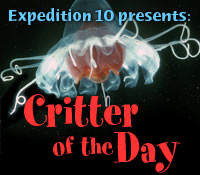|
  Try the PDF crossword puzzle » Stumped? Download the solution » March 4, 2006 by Kate Madin The barometer has been falling. A day ago, water began dashing against the lab’s portholes whenever the ship headed into a wave trough. By three in the afternoon, the L. M. Gould was rolling in swells taller than a person—taking about seven seconds to go from full right tilt to full left tilt—and things began to fall off the lab tables. Some in the group have even resumed taking seasickness medication. On the bridge, Chief Mate Kevin LeBouef had no problem with the weather—he’s seen worse. Kevin and Second Mate Dave Morse, along with Captain Scott Flanagan and Third Mate Larry Brissette are the men who pilot the ship. From the bridge, they take in a broad view of the surrounding ocean, and they all have weather stories to tell. “This isn’t bad,” Kevin said. “Last year, about this same time of year, crossing the Drake Passage, we had bad weather, with seas to 60 feet. The bridge is 48 feet high, and I was looking up at waves above my head.” Dave Morse has tales of weather, too. “Near South Georgia Island,” he said, “a storm blew up quickly, and some fishermen ended up adrift in a lifeboat, disoriented,” going away from land. “We (on a different ship at the time) were able to pick them up with the ship, and saved their lives. That was rewarding.” In the fall and winter, there is ice to contend with. “The ship’s spotlight shows big bergs at two miles,” said Dave, “but if it’s snowing and there’s sea ice, it’s taxing to see the open channel.” “You need to stay alert on the bridge,” said Kevin, “especially at night, for ‘growlers.’ ” These barely-submerged icebergs don’t show up on radar at all. “You scrutinize every whitecap,” he said, “because growlers have a particular pattern of waves breaking over them.” We see no ice, but all day the wind and swells have increased. At 8 p.m. we had 30-knot winds and seas to 25 feet. Much earlier, Jamee, Erich, and Josh put the LAPIS imaging instrument over the ship’s side to tow and left it in for five hours. They had a tense moment bringing it back on board. The one-of-a-kind, 1,200-pound prototype instrument swung wildly on the end of the winch wire with every wave, nearly hitting the ship—and their heads. “These swells are the highest I’d ever want to take the instrument out in,” said Erich. “It came close to being damaged, and we could have lost it.” With that, we were “weathered out.” We suspended sampling, towing, and diving for the day and night, hoping for calmer seas soon. The barometer, though, is still falling.
|
|||||||||||||||||||||||||||||||||||||||||||||||||||||||||||||||||||||||||||||||||||||||||||||
Mailing List | Feedback | Glossary | For Teachers | About Us | Contact
© 2010 Dive and Discover™. Dive and Discover™ is a registered trademark of Woods
Hole Oceanographic Institution




